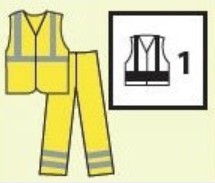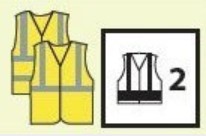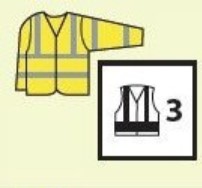High Visibility Clothing BS EN 471
Distribution:
Often work is carried out in situations which offer poor ambient lighting conditions. These conditions can sometimes be solved by introducing artificial task lighting as a control. However, it is always best to wear high visibility clothing, which is why high visibility clothing is one item of the basic three-point PPE system that most work sites accept as a required minimum. Even in well-illuminated conditions, high visibility clothing will help improve your conspicuity, alerting others, such as other workmen or moving vehicles and plant operators, of your presence. High Visibility clothing is manufactured and recognised to the standard BS EN 471. This standard identifies three classes of protection outlined in table 1.
|
Class |
Level of Conspicuity | Width of Retro-Reflective band | Minimum Background
Material |
Minimum Retro-Reflective Material | Example |
|
One |
Lowest | ≥50mm | 0.14m² | 0.10m² | Waistcoats and most trousers |
|
Two |
Intermediate | ≥50mm | 0.50m² | 0.13m² |
Waistcoats, jackets and some trousers |
| Three |
Highest |
≥50mm | 0.80m² | 0.20m² |
Jackets and overalls |
Only yellow (during construction works) or orange (during railway works) comply fully to EN471, whereas Red, Green and all other colours do not meet the specification. The logo for high visibility clothing shows a box with a high viability jacket logo in, alongside this is the clothing’s class.
 |
 |
 |
The level of conspicuity required is proportionate to the risk; although, some situations will accept class three high visibility clothing only, such as roadside working. Therefore, it is important to note that lower-class garments can be combined to achieve class three status, this is called an ensemble. For instance, a class two jacket and a pair of class two trousers may contain enough retro-reflective material to be classified as a class three garment. Additionally, retro-reflective tape may be used to increase the conspicuity, this is particularly required when the sleeve covers reflective strips on the torso. Finally, operatives should wear high visibility trousers class 1 when the carrying of large items of equipment or other activities may at any time obscure the visibility of the high visibility jacket or vest.
Need more information? Our team of expert consultants can advise on PPE and more – get in touch!
